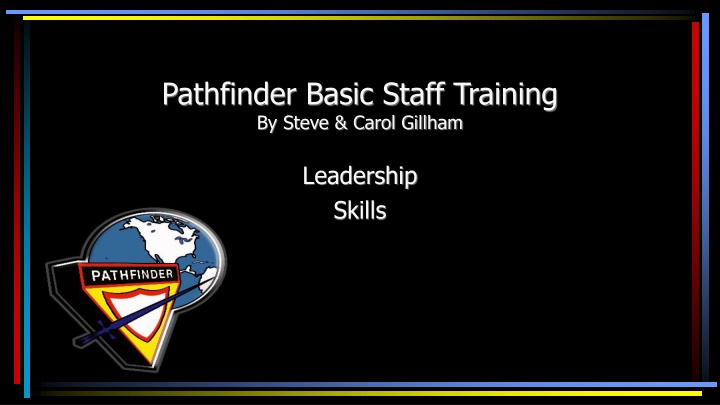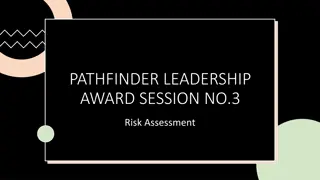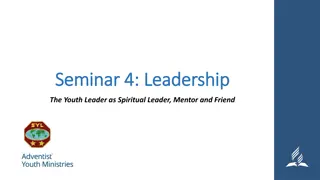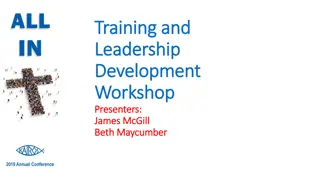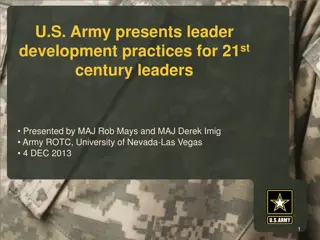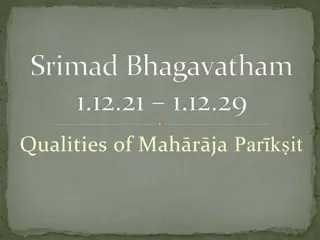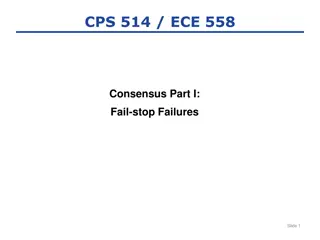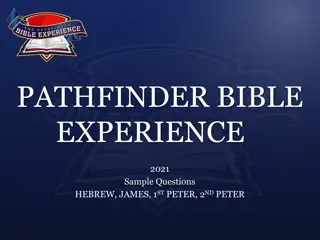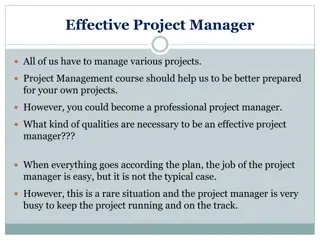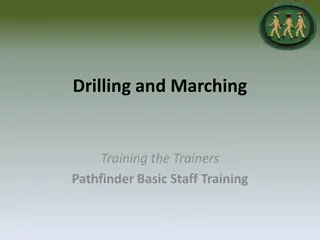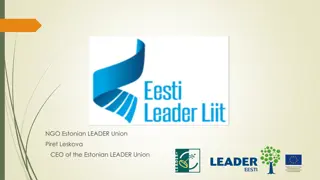Qualities of an Effective Pathfinder Leader
Leadership in Pathfinder training involves influencing and guiding individuals to follow a Christ-centered life, develop skills, and maintain good relationships. A successful Pathfinder leader possesses qualities like integrity, vision, emotional stability, and cooperation. They are enthusiastic, resourceful, and able to delegate effectively. Additionally, as part of a successful team, being likable, cooperative, and action-oriented are key traits for all staff members.
Download Presentation

Please find below an Image/Link to download the presentation.
The content on the website is provided AS IS for your information and personal use only. It may not be sold, licensed, or shared on other websites without obtaining consent from the author.If you encounter any issues during the download, it is possible that the publisher has removed the file from their server.
You are allowed to download the files provided on this website for personal or commercial use, subject to the condition that they are used lawfully. All files are the property of their respective owners.
The content on the website is provided AS IS for your information and personal use only. It may not be sold, licensed, or shared on other websites without obtaining consent from the author.
E N D
Presentation Transcript
Pathfinder Basic Staff Training By Steve & Carol Gillham Leadership Skills
Definition of Leadership Leadership is Influence Leadership means you have people who follow you, otherwise you re just out taking a walk John C. Maxwell
Qualities of a Pathfinder Leader Draw the perfect Pathfinder leader Include Written: Qualities Skills Attitudes
Qualities of a Pathfinder Leader Lives a Christ-centered life Loves young people Has a vision (knows WHY they re involved) Has a mission (knows HOW they re doing it) Has integrity (keeps commitments) Understands the developmental characteristics of pre-adolescents and adolescents
Qualities of a Pathfinder Leader Enjoys learning new skills Develops the ability to organize Maintains good working relationships with fellow staff Radiates a dignity of presence that assures order Possesses emotional stability Enjoys being outdoors
Qualities of a Pathfinder Leader Maintains good relations with parents Is able to delegate responsibility and authority Has a sense of humor Is resourceful and creative Enlists a spirit of cooperation Is optimistic and enthusiastic Chooses capable helpers & staff
Qualities of a Successful Team Player (all staff) Be likeable Be generous with praise Ask people s advice Make people feel important Never embarrass anyone Lead instead of drive Remember names Keep promises and commitments
Qualities of a Successful Team Player (all staff) Be happy and optimistic Do not brag Don t make decisions when emotionally upset Heal hurts quickly Be a person of action Be cooperative Be early
Qualities of a Successful Team Player (all staff) Be prepared Plan 1 hour of activity for each 30 minute of meeting time
Five Styles of Leadership 1) Authoritative (Autocratic) 2) Evaluative 3) Bureaucratic (Political) 4) Democratic (Participative) 5) Laissez-faire
Five Styles of Leadership 1) Authoritative (Autocratic) Leader Retains as much power and decision- making authority as possible. Does not consult staff, nor are staff allowed to give any input. Staff & Pathfinders must obey orders Motivation is produced by creating a structured set of rewards and punishments.
Five Styles of Leadership Authoritative (Autocratic) Leader Advantages Lots of things get done Things are very organized Poorly managed becomes highly managed
Five Styles of Leadership Authoritative (Autocratic) Leader Disadvantages Creativity & staff involvement is low If leader leaves, vacuum of leadership is left behind. Can create soldiers instead of involved Pathfinders and staff LOTS of TURNOVER! Pathfinders is a VOLUNTEER organization
Five Styles of Leadership 2) Evaluative Similar to Authoritative, except that the leader asks for input and MIGHT include that input in the decisions, but will usually not acknowledge the involvement of others in the process
Five Styles of Leadership 3) Bureaucratic (Political) Leader Everything done by the book, according to procedure or policy. If it isn t covered by the book, the leader refers to the next level above him or her. Police officer -- He or she enforces the rules.
Five Styles of Leadership Bureaucratic (Political) Leadership Advantages Rules are clearly understood and defined Staff & Pathfinders know what to expect Discipline is easily handled
Five Styles of Leadership Bureaucratic (Political) Leadership Disadvantages Low involvement of Pathfinder staff Little room for adaptability Rules may not apply to current situation
Five Styles of Leadership 4) Democratic (Participative) Leadership Staff are part of the decision making. Communicates what is happening and expects involvement and responsibility of staff. The coach leader has the final say, but gathers information from staff members before making a decision.
Five Styles of Leadership Democratic (Participative) Leadership Advantages Staff are involved -- buy-in Somewhat adaptable to match situation If leader leaves things usually continue Everyone feels like part of the team. Creativity is HIGH
Five Styles of Leadership Democratic (Participative) Leadership Disadvantages Rules may not be as well defined, known, or understood Structure is usually looser Discipline may be a problem if consequences aren t clearly defined.
Five Styles of Leadership 5) Laissez-faire Leadership Hands-off style. Leader provides little or no direction and gives staff (& Pathfinders) as much freedom as possible. All authority or power is given to the staff (& Pathfinders) and they must determine goals, make decisions, and resolve problems on their own.
Five Styles of Leadership Laissez-faire Leadership Advantages Highly skilled staff flourish (for awhile) Lots of creativity Staff with drive make lots of things happen Lots of adult involvement (though not particularly committed).
Five Styles of Leadership Laissez-faire Leadership Disadvantages Disorganization is a danger Quality can decline over time Discipline can be an issue Rules may not exist or be followed thru Pathfinders can take advantage of individual staff member s strengths and weaknesses Long term membership involvement often declines
Job Description of A Club Director Serve on Church Board as Pathfinder Representative Responsible for the planning of the overall calendar of events for the club Organizes regular club meetings & events Resource person for counselors & instructors who need assistance Responsible for communication with Conference on a regular basis
Job Description of A Deputy Director Assist Director in their duties Responsible to be sure that the AY Classwork is being completed by units Responsible for communication & coordination with instructors & chaplain May serve as Secretary/Treasurer May have a special area of responsibility related to the overall Pathfinder program
Job Description of A Club Secretary/Treasurer Responsible for record keeping including: Conference Forms & Reporting Attendance Responsible for club finances including: Income from dues, fundraising, outings, donations, uniform Payment & recording of expenditures Coordinate with Church Treasurer Registration Supply ordering
Job Description of A Unit Counselor Leads unit of 4-8 boys or girls Closest contact with kids and parents Works with unit throughout Pathfinder program & events Prepares unit for investiture (Classwork, AY Honors) Develops friendship & understanding with unit members
Job Description of An Instructor Teaches specific skills or subjects such as Bible, personal growth, outdoor skills, honors, or crafts May come from church or community to assist temporarily with club Is well acquainted with subject matter and matches it with club curriculum
Job Description of TLT (Teen Leader In Training) High school student who commits to learning more about leadership in the Pathfinder organization Assists staff members in all functions of the club During 4-year program, is trained in club administration, counseling, classwork & honors, finances, outreach, camping, & security
General Job Description for All Staff Baptized member of SDA Church Good example to Pathfinders in their conduct and Christian commitment Willing to commit the time required to prepare and attend Pathfinder meetings & activities
Local Pathfinder Organizational Chart Club Director Deputy Director Secretary/Treasurer Instructors Counselors Parents TLT's Pathfinders
